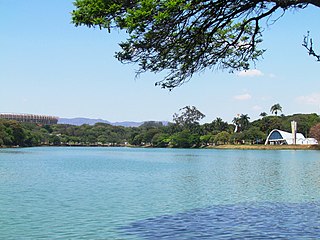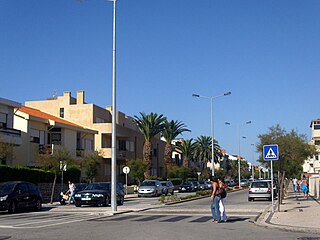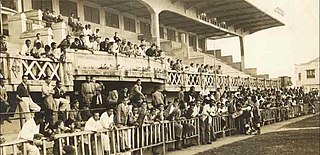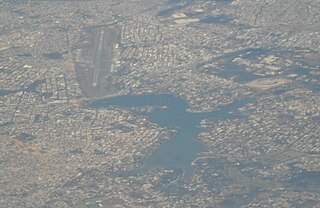
Belo Horizonte is the sixth-largest city in Brazil, with a population of around 2.3 million, and the third largest metropolitan area, with a population of 6 million. It is the 13th-largest city in South America and the 18th-largest in the Americas. The metropolis is anchor to the Belo Horizonte metropolitan area, ranked as the third most populous metropolitan area in Brazil and the 17th most populous in the Americas. Belo Horizonte is the capital of the state of Minas Gerais, Brazil's second-most populous state. It is the first planned modern city in Brazil.
Cruzeiro, generally the Portuguese language term for a large cross, may refer to:

Pampulha–Carlos Drummond de Andrade Airport is an airport serving Belo Horizonte, Brazil, located in the neighborhood of Pampulha. Since December 16, 2004, the airport is also named after the Minas Gerais-born poet Carlos Drummond de Andrade (1902–1987).

Mineiro, Mineirês, or the Brazilian mountain accent is the Brazilian Portuguese term for the accent spoken in the Center, East and Southeast regions of the state of Minas Gerais.

Mineirinho Arena, sometimes called just Mineirinho, is the biggest indoor sporting arena in Brazil. Located in Belo Horizonte, Brazil, the arena holds 25,000 people.

Lake Pampulha is an artificial lake located in Pampulha, Belo Horizonte, Brazil. It is also the name of an administrative region of Belo Horizonte, and the name of one of 29 neighborhoods (bairros) within the administrative region of the same name. The lake was built in the early 1940s during the mayoralty of Juscelino Kubitschek, later president of Brazil from 1956 to 1961. Pampulha was created as a source of water for the city of Belo Horizonte, but quickly became polluted.

Bairro Norte is a quarter and district of the Portuguese city of Póvoa de Varzim. it is the most densely populated district of the city, it is also a beach resort. In the 19th century it was known as Bairro de S. José.

Ibirité is a Brazilian municipality located in the state of Minas Gerais. The city belongs to the mesoregion Metropolitana de Belo Horizonte and to the microregion of Belo Horizonte. Its population in 2020 was 182,153.

Venda Nova is a neighborhood (bairro) of Belo Horizonte, the third largest city in Brazil. It is situated on the northern side of the city, between the downtown area and the Belo Horizonte International Airport. It is known, among other things, for the "Quadras do Vilarinho" and Shopping Norte. One of the principal arterial roads in the area is the Avenida Vilarinho that connects to Pedro I/Antônio Carlos e Cristiano Machado Avenues. These connect the area to the center of Belo Horizonte.

Planura is a municipality in the west of the Brazilian state of Minas Gerais. As of 2020 the population was 12,292 in a total area of 318 km2. It became a municipality in 1962.

Cabo Verde is a Brazilian municipality located in the southwest of the state of Minas Gerais. Its population as of 2020 was 14,075 people living in a total area of 367 km². The city belongs to the meso-region of Sul e Sudoeste de Minas and to the micro-region of São Sebastião do Paraíso. It became a municipality in 1877. The municipality is an important producer of coffee.

Savassi is a neighborhood in Belo Horizonte, Brazil. It is located at the Central-South zone city district. Savassi is known for having a large number of bars, pubs, clubs, cafés, bistros, diners, restaurants, nightlife and shopping commerce. The region is regarded as one of the most prestigious and sought-after areas in Belo Horizonte.

The Praça da Liberdade is a principal square in the Savassi neighborhood in the city of Belo Horizonte, Minas Gerais, Brazil.

Bartolomeu de Gusmão Airport was a Brazilian airport built to handle the operations with the rigid airships Graf Zeppelin and Hindenburg. The airport was named after Bartolomeu Lourenço de Gusmão (1685–1724), a Portuguese priest born in Brazil who did research about transportation with balloons.
Carlos Prates Airport was one of the airports serving Belo Horizonte, Brazil. It was named after the neighborhood where it is located and this, in turn, was named after an Engineer that planned parts of Belo Horizonte. It was operated by Infraero.

The Estádio Presidente Antônio Carlos, commonly known as Estádio de Lourdes and colloquially as Estadinho da Colina was a stadium located in Belo Horizonte, Brazil, owned by Atlético Mineiro. The ground, opened in the Lourdes neighborhood on 30 May 1929, had an estimated capacity of 5,000 and was Atlético's home until 1950. It remained largely unused by the first squad until its demolition in 1994, when a shopping mall was built on the site.

Pampulha is an administrative region in the city of Belo Horizonte, Brazil. It is one of nine administrative regions of Belo Horizonte, and occupies 47.13 kilometres (29.29 mi) in the northeast of the city. It has a population of 145,262 and a population density of 3.08 per square kilometer. The center of the Pampulha is occupied by Lake Pampulha, an artificial lake constructed in the early 1940s by Mayor Juscelino Kubitschek, later president of Brazil from 1956 to 1961. The Pampulha administrative region is further subdivided into 29 neighborhoods (bairros), one of which is also called Pampulha.
Centro is a neighbourhood of Belo Horizonte, located in the central region of the city.
Pena de Pavão de Krishna is a carnival block in Belo Horizonte, Brazil. It was founded in 2013. The block parades in the Sunday of the carnival week playing Afoxê.














